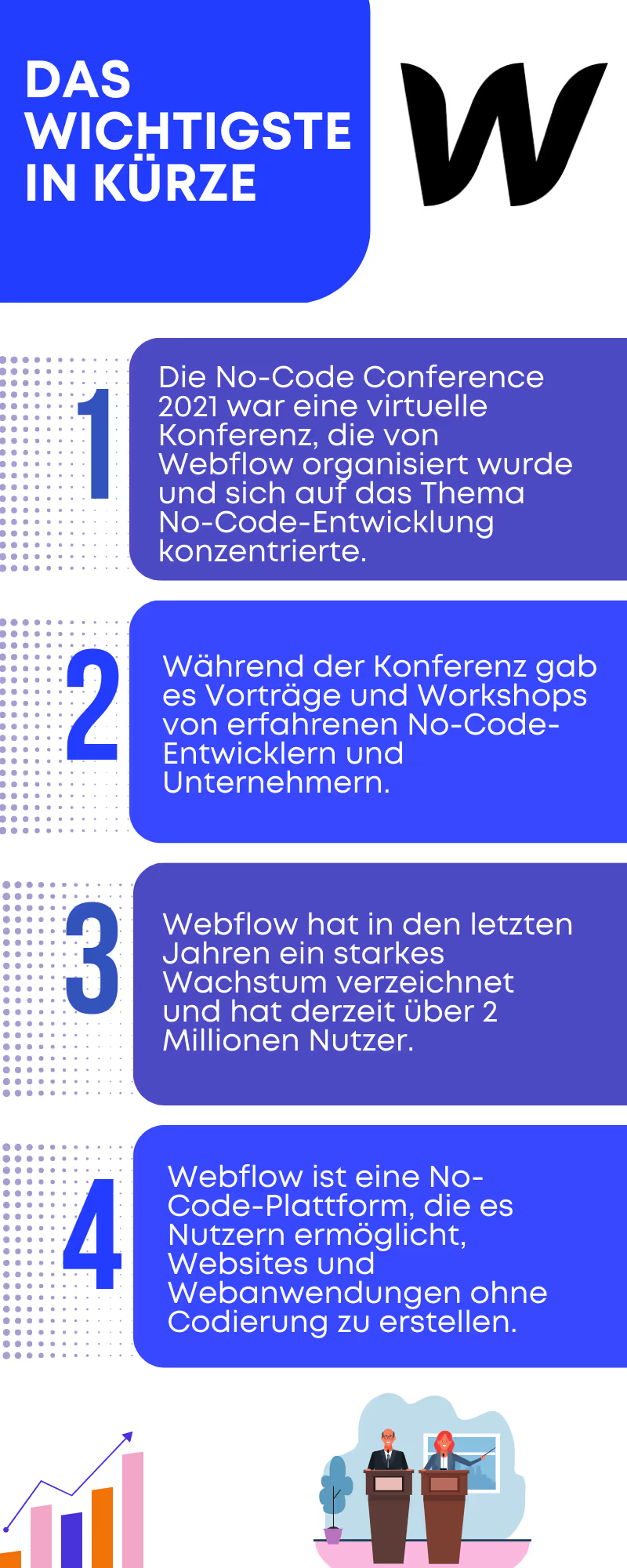News about memberships, logic and more - The No-Code Conference 2021
Learn how the new announcements and key features of the web are brought together in one platform.
Here you can find everything that was announced at the No-Code Conference 2021. No-code bridges the knowledge gap in software development. Today, only 0.5% of the world's population can code, but with no-code, the power of web development becomes more accessible and gives more people the power to bring a big idea to life. Webflow is proud to have been part of the no-code movement since 2013. Since the start, the Webflow team has developed features that enable more people around the world to build world-class, award-winning websites and businesses. Webflow's efforts to create the best visual web development platform on the market have so far focused on developing tools that enable people to build powerful user interfaces and visually manage data — without having to write code.
At the “No-Code Conference 2021" virtual event, expanded features and updates were announced that make it even easier to create engaging web experiences — without any code:
- Memberships: The beta version of memberships makes it possible to add paid membership features to a website.
- Logic: A new feature was also announced that allows users to set workflows and automations based on self-defined conditions.
- Collaboration: New workspaces have been announced that make it possible to work with and scale teams in Webflow.
- Blend mode: Users can now control how elements are blended directly from the style panel, bringing the “blend mode” CSS property directly into Webflow.
- Background filters: With background filters, you can create blur and color shift effects for the area behind an element by using the “background filter” CSS property directly in Webflow.
- Improved accessibility guide: Following the beta release, new improvements to the audit panel were officially introduced, making it even easier to create accessible websites.
- CMS performance improvements: Webflow has updated the data architecture so that loading a project in Webflow Designer is now up to 15 times faster, requires 6 times less memory in the browser, and requires an astonishing 86 times less bandwidth when loading.

Webflow and community growth
When Webflow started the No-Code Conference over two years ago, they couldn't imagine how much No-Code, Webflow, and the community would grow.
Since the last conference, the Webflow community has published over a million websites. In 2021, 1 million users joined the community, bringing the total number of Webflow users to over 3.5 million. Webflow pages have had over 10 billion website visits in the last month alone. This breathtaking growth not only speaks to the power of Webflow, but also clearly shows that no-code is the future — whether you're an agency, a marketing team, a small company, a large company, or a freelancer.
Webflow highlights:
- Nirav Suthar, who grew his design consulting firm from 0 to 100,000 US dollars with Webflow in just over a year and now counts Johnson & Johnson and Gumroad among his clients.
- MURAL, whose marketing team has increased their development speed tenfold since switching to Webflow.
- Attentive, which switched from Wordpress to Webflow and saw a significant jump in traffic, keyword rankings, and impressions
These are just a few examples of inspiring stories from the community and Webflow customers. Webflow is the tool of choice for the most innovative individuals, agencies, and companies who need powerful tools to build and host world-class websites without being tied to long development times.
memberships
Webflow memberships, a collection of new features that together open up the ability to create powerful membership pages in Webflow.
Memberships in Webflow are made possible by three new features that have been integrated directly into the designer:
- User database: By adding users to your website, you can manage your user database directly from the Webflow designer. You can manage email more easily, such as recovering passwords needed for a smooth user experience.
- Access groups: Gives you full control over sharing content, depending on which user is signed in.
- Subscriptions: This allows us to charge a user or group for access to content, whether it's a one-time payment for lifetime access or a recurring subscription that's billed monthly or yearly.
With this new feature, you have no limits — you can create member-only experiences and personalize those experiences for your users. If you're a freelancer or work for an agency, you can now create spaces that are only accessible to clients while having complete design control.
Introducing Logic
With this new feature, user-defined workflows can now be created that are based on personally defined conditions. That means that as a result of an action on your website — such as submitting a form — it's no longer just one thing happening, but that there can be hundreds of options based on the experience.
As always, this is managed entirely via Webflow Designer without any code. That means you can build and implement business logic without hiring a developer or writing complex code. Logic in Webflow simply takes the rules you set in the designer and automatically executes them for you.
Logic will be available in 2022. From updating and managing website content to engaging with customers, Logic opens up endless ways to use Webflow's powerful features.
Continuous improvements for teams in Webflow
To ensure teams can easily collaborate on Webflow, there are two additional features released earlier this year.
- Workspaces that facilitate team growth. This makes it easy to create, grow, and modify your team in Webflow. Individual and team account plans are combined in a uniform “workspace” plan, which allows you to easily grow in a team from one person to any desired size.
- New billing and publishing permissions. Aside from simplicity and scalability, one of the big improvements Workspaces will introduce is the new user roles and permissions. This allows you to control who can do what within your account and even within individual projects.
New designer controls
The Webflow designer's capabilities are expanded. In addition to industry-leading style and layout features, there will be the introduction of a blend mode and background filters to take your websites to the next level.
With the new mode, you can control how the colors of stacked items blend together and preview the changes live. This brings the “blend mode” CSS property directly into Webflow and saves time. Blending mode is new to Webflow and can now be used. With background filters, you can create blur and color shift effects for the area behind an element by adding the CSS “background filter” property directly into Webflow. The live preview allows you to quickly visualize the various options and find the preferred filter. Sites like Apple.com have used this effect to achieve designs.
It's now even easier to make the website barrier-free — the audit panel comes out of the beta phase with five new improvements. These improvements make it possible to quickly identify and fix accessibility issues before you publish your site
Here's what you can expect:
- In-product guides to help you fix any identified accessibility issue
- Colored panel icon for newly discovered audits
- Pending audits can now be found in the “Publish” drop-down menu
- Option to ignore individual audit suggestions
- Alt text verification for fields with multiple images
Faster and more dynamic data
CMS performance improvements
Data is the engine of all Webflow websites. Take our CMS, for example, which is used by 68% of Webflow pages. Designers are able to design and create using dynamic data while maintaining full control over custom layout. All without having to write CSS, set up or manage databases.
And now the data is also being upgraded.
These changes to the data architecture are primarily about increasing performance. It redesigned the way your website loads and consumes your CMS and e-commerce article data. This means that the data is only loaded when you or the designer need it and only in the form required by the CMS Performance Improvements Beta. This means that your website's performance for websites with CMS elements and e-commerce products will significantly improve, and data-intensive websites will be faster and more flexible.
With this change, the designer will be up to 15 times faster than before, using 6 times less memory in the browser. You also need 86 times less bandwidth when charging. One of the leading Webflow expert partners has already noticed the difference. “Our biggest projects now load much faster,” says Joe Krug, founder and CEO of Finsweet, “Projects with more than 3,000 CMS elements now feel like lightweight projects with 100 elements. These CMS performance improvements are available in private beta starting today, so you can experience these monumental performance changes right away.
Shaping the future with no-code
By combining UI (designer), data (CMS, e-commerce, memberships) and now Logic, a unified method was created that allows you to visually work with all three pillars of software development, making Webflow a truly integrated development platform. Now you don't have to assemble different tools, you can build your website in one place.
Webflow is committed to making it possible for anyone to develop for the web. With the introduction of these new functions, major milestones were set for the company.









Recommend this post